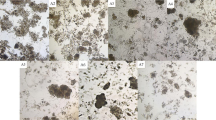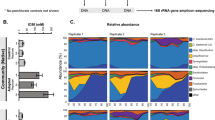Abstract
WHILE investigating the removal of pyritic sulphur from coal by a microbiological method, we propagated large numbers of the chemoautotrophic iron-oxidizing bacterium Ferrobacillus ferrooxidans. During mass culture of the bacterium in an inorganic iron salts medium (9K)1, it was observed that alterations in cellular morphology occurred in response to excessively vigorous aeration. Normal cells measure 1.0–1.7µ by 0.5µ (Fig. 1A), while the abnormal (morphologically altered) cells differed by having a diameter of 1.0µ, so that many enlarged, coccoidal forms were present (Fig. 1B). The abnormal strain, on large-scale sub-culture using less vigorous aeration, or in shake-culture flasks, showed virtually complete reversion to the normal morphology after the second transfer (Fig. 1C, D).
This is a preview of subscription content, access via your institution
Access options
Subscribe to this journal
Receive 51 print issues and online access
$199.00 per year
only $3.90 per issue
Buy this article
- Purchase on Springer Link
- Instant access to full article PDF
Prices may be subject to local taxes which are calculated during checkout
Similar content being viewed by others
References
Silverman, M. P., and Lundgren, D. G., J. Bact., 77, 642 (1959).
Beck, J. V., J. Bact, 79, 502 (1960).
Author information
Authors and Affiliations
Rights and permissions
About this article
Cite this article
SILVERMAN, M., ROGOFF, M. Morphological Variation in Ferrobacillus Ferrooxidans related to the Rate of Iron Oxidation. Nature 191, 1221–1222 (1961). https://doi.org/10.1038/1911221a0
Issue Date:
DOI: https://doi.org/10.1038/1911221a0
Comments
By submitting a comment you agree to abide by our Terms and Community Guidelines. If you find something abusive or that does not comply with our terms or guidelines please flag it as inappropriate.



